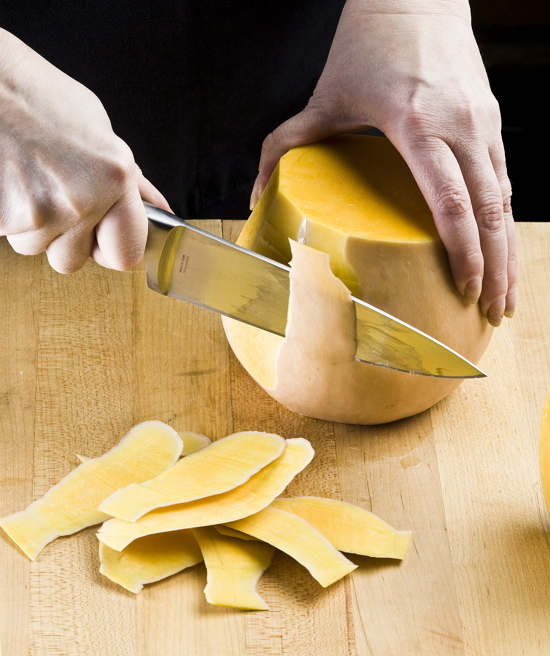Doing a lot of cooking over the holidays? We’ve gathered some tricks and tips from our reporting to help you with the little things.
Peeling squash: Attack it like chefs do when making supremes, those jewel-like, membrane-less sections of orange. This works best with smooth-sided squash, like butternut. Cut the vegetable in sections crosswise. Place a piece flat on the cutting board. Place the knife blade at the top, just inside the peel. Cut in a downward stroke to remove the peel, with the knife blade slicing just behind the skin. Continue around the piece; repeat with remaining pieces. If you lose a little extra flesh, no problem; the gain in speed and convenience is worth the slight loss. Halve and remove seeds, then proceed with your recipe.
Making gravy gluten-free: Whatever the reason you avoid wheat flour, you can thicken pan juices for gravy with cornstarch or potato starch. For every 1 1/2 to 2 cups liquid, first dissolve 1 tablespoon corn or potato starch in 1 tablespoon of cool water, then add to gravy liquids. Heat to a gentle boil to thicken. Or add instant mashed potato flakes (about 1/4 cup per 1 cup of gravy liquids) as the folks at Butterball Turkey Talk-Line suggest.
 |
Peeling squash: Place the knife blade at the top of the squash, just inside the peel. Slide the knife downward, cutting away the peel. Turn and repeat. (Tribune Content Agency) |
Don’t want to fuss with stuffing the bird? Whether roasting a goose or turkey, use the cavity to build flavor instead. Tuck in wedges of fruit (apples, pears, orange), chunks of vegetables (onions, carrots, celery), a couple of smashed garlic cloves, plus a few stems of fresh herbs (parsley, thyme).
Cleaning leeks: As wonderful as they may be in a recipe, leeks can often be a real pain to clean. A member of the onion family, leeks look like large green onions with a thick stalk or base. Because the white part of the base is prized in cooking, farmers mound dirt around the leeks to keep out the sunlight, extending the white as the leek grows. Unfortunately, a lot of that dirt and grit ends up between the layers of the leeks as they grow. To clean a leek, peel and discard any old outer leaves, then trim the leek of the dark green leaves and base, reserving the white and any of the very light green base. Slice off the root end, then halve the leek lengthwise. Rinse the leek under cold running water, feeling between the layers to loosen and dislodge any dirt or grit. Finally, slice and use as desired.
Roasting chestnuts over an open fire? You probably already know to cut a small X in each, down through the shell, or you’ll have mini and messy explosions ― and Santa may sue. The cuts will also help you peel the shells, but another trick is nearly as vital: Immediately after removing the chestnuts from the fire (or oven, where you have roasted them at 400 for about 20 minutes), gather them in a dish towel, place the bundle on the counter and crush firmly with your hands. You’ll hear lots of pleasant crackling, meaning you’ve broken up and loosened the shells, making peeling a dream. But peel while they’re still warm, or you’ll never get the inner skins off.
Let it rest: One of the easiest ways to make sure that roast pork, goose, turkey, lamb or beef remains juicy when you serve it is to let the thing sit. And longer than you may think: about 30 minutes for larger roasted meats. Don’t worry that it will get cold; in fact, the internal temperature will rise 5 to 10 degrees, again depending on the beast, as it continues to cook from carryover heat. (So you should be pulling that turkey from the oven at about 160, not the 165 finished temp.) Resting the meat also firms up its structure, making it easier to carve, according to food science guru Harold McGee in “On Food and Cooking.”
Making cookies: When rolling out a cookie dough, first flatten the dough with your hands to get it closer to the final thickness. Keep the rolling pin near the center of the dough as you roll; when you roll to the rim, you tend to flatten the edges too much, making the dough uneven. This can lead to uneven baking. (The rolling tips apply to pie crusts as well.) Trying a new cookie recipe? Be sure to measure ingredients carefully, especially the flour. Use the scoop and sweep method: Scoop down into the flour with your measuring cup (dry cup measure, never a liquid measure), then level it with a knife. Scoop flour from a bin, not the bag it comes in, where it can become compressed. Take care, as well, with measuring when portioning the dough into individual pieces. Ever wonder why a recipe says it makes 54, but you get 36? Most likely the problem lies in how much dough is measured out for each cookie. Recipes can be maddeningly inexact when it comes to this. (Your heaping teaspoon may be much larger or smaller than mine.) Try to follow the portioning directions precisely; the cookie sizes may affect baking time. If nothing else, keep a close eye, checking the cookies long before listed baking times. Finally, some recipes call for sifting flour, but few mention cocoa powder, which is strange because cocoa seems to always have lumps. Sift it before adding to recipes.
(Tribune Content Agency)








